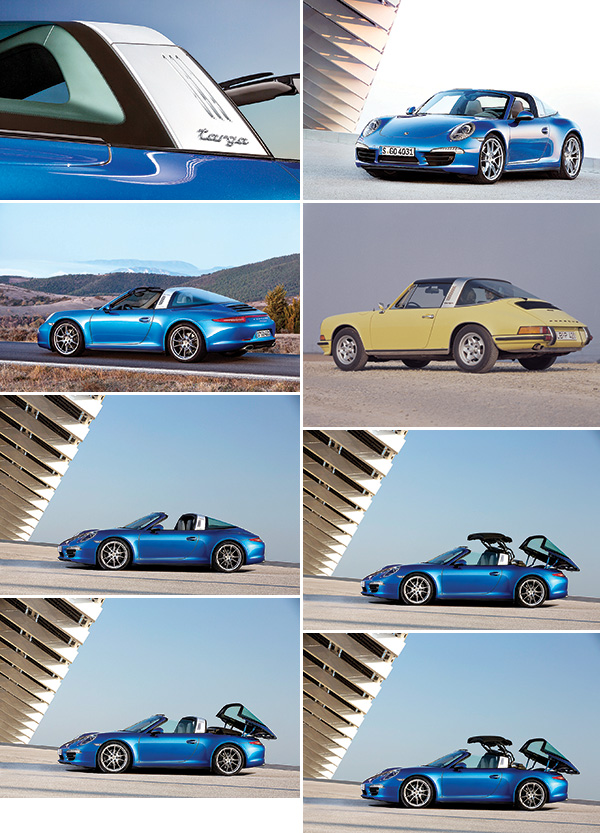The new Porsche 911 Targa: Rebirth of a modern classic
MANILA, Philippines - Porsche is expanding the current generation of the 911 – the new Targa 911 now joins the coupé and convertible in the product line-up. Since its launch in 1965, the Targa has held a firmly established position within the Porsche 911 family, representing about 13 percent of all 911 cars ever sold. Porsche has produced more than 853,000 units of the 911 sports car icon since production started about 50 years ago. In the anniversary year of 2013 alone, more than 30,200 Porsche 911 cars were transferred to their proud owners.
The latest generation of this extravagant 911 variant now combines the classic Targa concept with highly advanced roof-activating convenience. Just like the legendary original Targa, the new model has the characteristic wide bar in place of the B pillars, a moving roof part above the front seats and a wraparound rear window without C pillars. Unlike in the older classic models, the roof panel is now opened and closed at the press of a button. The fully automatic roof system stows the roof behind the rear seats in a spectacular way. The latest version of the 911 features the typical Porsche PTM all-wheel drive system that by design transfers proportionately more power to the rear wheels. This system guarantees maximum driving performance on a variety of road surfaces and in all weather conditions.
Two model versions with all-wheel drive exclusively
Like its predecessor, the new Targa is launching onto the market in two variants with all-wheel drive exclusively. In the 911 Targa 4, the heart of a 3.4-liter flat-6 engine beats with a power output of 350 hp. Fitted with 7-speed PDK gearbox and the Sport Chrono package, the new 911 Targa accelerates from 0 to 100 km/h in 4.8 seconds and, reaches a top speed of 282 km/h with a manual transmission. The top model is the 911 Targa 4S which develops 400 hp from a 3.8-liter flat-6. Its top speed is 296 km/h, and it handles the benchmark sprint to 100 km/h in 4.4 seconds when equipped with PDK and the Sport Chrono package. The car’s performance (as well as fuel efficiency) is equivalent to those of the 911 Carrera 4 Cabriolet.
New and spectacular: fully automatic Targa roof
The roof system consists of two moving parts: a soft top and a glass rear window. At the press of a button, the glass rear window opens to the rear and tilts. It is joined to the stowage box lid. At the same time, two flaps in the Targa bar open and release the soft top. The soft top is unlatched, folds then stows behind the rear seats. A panel running across the car behind the rear seats integrates the soft top. Finally, the flaps in the bar and the rear window close. When the top is stowed, a wind deflector integrated in the cowl can be adjusted manually. It reduces draught to the interior significantly.
While the car is stationary, the roof can be opened or closed in about 19 seconds from controls on the center console. To protect the car from damage, the standard integrated rear ParkAssist monitors the area behind the 911 Targa while the roof is opened and closed. If the sensors detect an obstacle within a range of less than 40cm, a warning sounds. This prevents the rear window that is being tipped back from colliding with a closely parked vehicle or other object standing behind the car.
Independent and extravagant: history of the Porsche 911 Targa
In September 1965, Porsche presented the 911 Targa at the Frankfurt Motor Show as the world’s first safety-engineered cabriolet. With its fixed roll-over protection bar, removable folding roof and downward folding rear window, the new 911 variant mainly addressed the heightened awareness of safety felt by American customers. The word Targa is derived from the famous Italian road race, the Targa Florio. Since the middle of the1960s, it has stood for the open-top concept which was new at the time. Porsche has had the name protected.
Production started at the end of 1966, and the 911 Targa was launched on the market in 1967. The half-open 911 model cost 1,400 German Marks more than the coupé. Development of the roof concept continued from one 911 generation to the next for 27 years. During this time, the “half-open” variant attained the status of an independent vehicle concept in the Porsche model portfolio. On average, one in ten 911 customers opted for this approach.
In the model year 1996, Porsche presented a totally revised version with the 911 Targa (type 993). Starting with this type, the entire roof was designed as a continuous glass panel. The front glass sunroof was lowered and stowed under the folding glass rear window.
Exactly 20 years after Porsche discontinued the last 911 Targa with a classic roll-over protection bar based on the Type 964, the new generation now carries on in the tradition of the original body concept.
For more information please contact Porsche Center Philippines at 7270381 to 85 or visit its show-room located at 201 EDSA Mandaluyong City.
- Latest






























